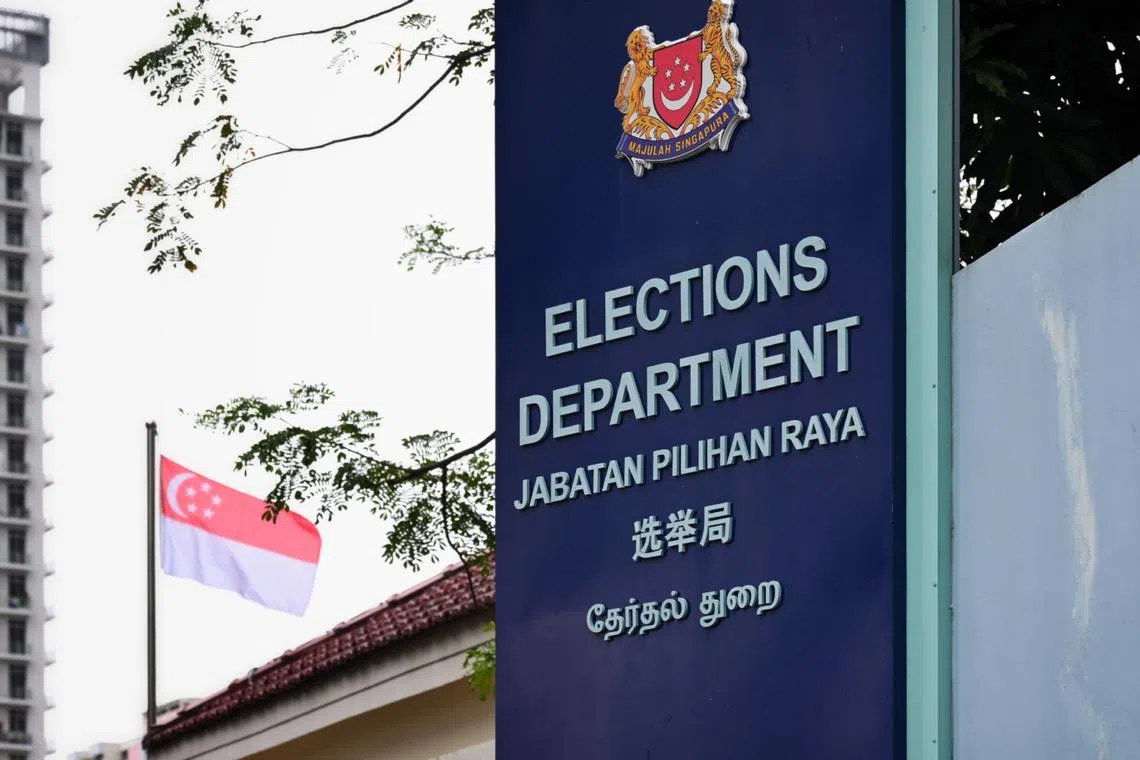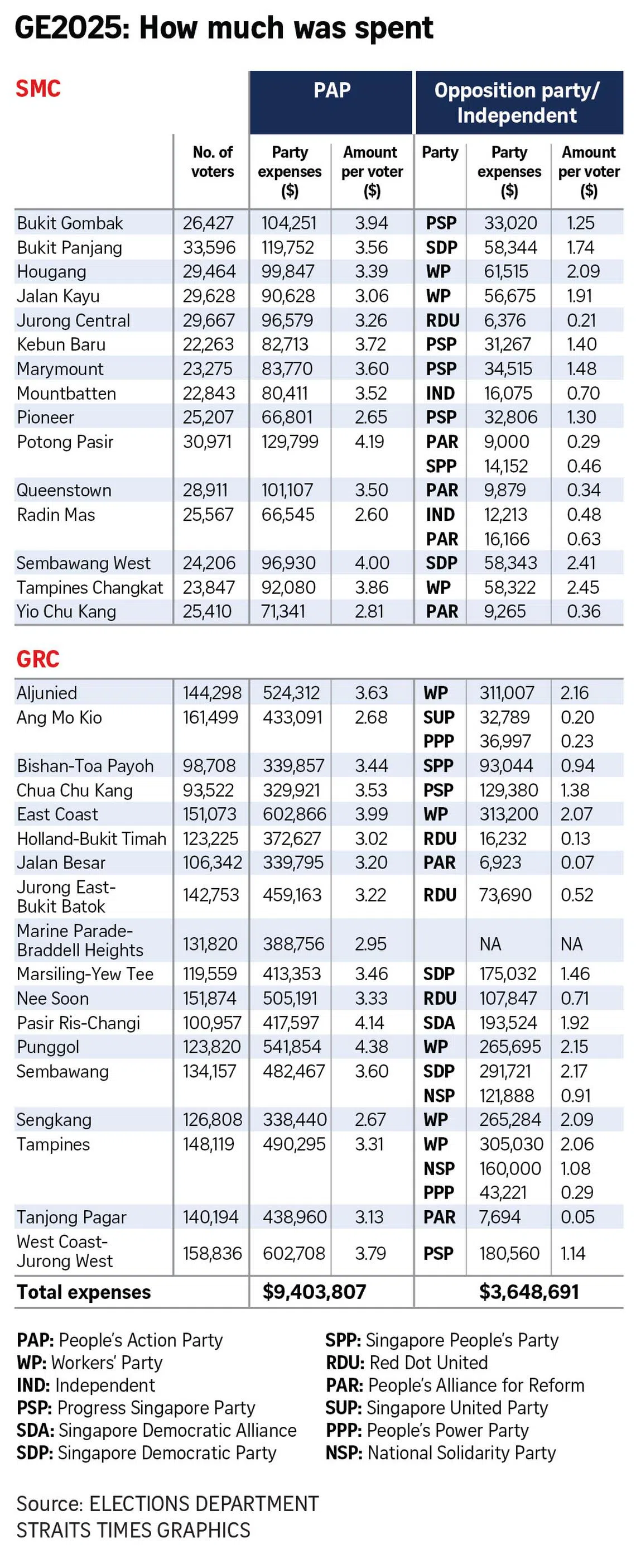$13m spent on GE2025 campaign, PAP spent $9.4m against $3.6m by the opposition
Sign up now: Get ST's newsletters delivered to your inbox

Online advertising made up about 16 per cent of total costs, while political parties spent a combined $1.7 million - or about 13 per cent - on physical rallies.
PHOTO: ST FILE
Follow topic:
SINGAPORE – Candidates spent slightly over $13 million at the 2025 General Election in a bid to garner votes from Singaporeans, with almost half of this going to non-online advertising such as posters and banners.
Online advertising made up about 16 per cent of total costs, while political parties also spent a combined $1.7 million – or about 13 per cent – on physical rallies, which made a return after being ruled out at the last general election due to the Covid-19 pandemic.
The remainder of the spending went to other costs such as office rental, equipment, supplies and transport.
Overall, spending by parties increased by about 42 per cent from the 2020 General Election, where total expenditure was $9.2 million. But the proportion spent on online advertising dropped from 2020, when it was 22 per cent.
A total of 211 individuals took part in the May 3 polls
The ruling People’s Action Party spent the most – $9.4 million in its contests for all 97 seats in the House – against a combined $3.6 million from the 10 opposition parties and two independent candidates.
The Workers’ Party spent the most out of opposition parties, forking out a total of $1.6 million for its 26 candidates.
Next up was the Singapore Democratic Party, which spent $583,440 for its 11 candidates, followed by the Progress Singapore Party, which spent $441,548 for 13 candidates.
ELD had earlier released two tranches of election expenses for public inspection online. The filings are available for six months from the date they are put online.
Most parties spent more in 2025 than at the last general election. The PAP’s spending increased from $6.97 million on 93 seats at GE2020, while the WP more than doubled its spending from $705,647 then.
The PSP’s spending, however, dropped from $781,275 at the last election, with the party reducing its number of candidates from 24 to 13 in 2025.
These figures reflected party strategies during the nine-day campaign in late April and early May.
The SDP, which held rallies every night, including twice on the last day of hustings when it added a lunchtime rally, dedicated almost 40 per cent of its total spending to them.
The WP, similar to past elections, did not spend much on online advertising, with only $540 allocated to it.
Over two-thirds of its expenditure – $1.1 million – was instead on non-online advertising.
The PAP, on the other hand, spent about 43 per cent of its total budget – around $4 million – on this category and dedicated slightly more than a fifth to online advertising, coming up to slightly more than $2 million.
The National Solidarity Party spent $3,733 out of a total $281,888 on rallies. It was the only party to not hold any physical rallies, although it held one online rally. The bulk of its spending – $185,934 – went to physical advertising.
Singapore Management University law don Eugene Tan said the increase in spending tracks with the increase in the cost of goods and services since the last election.
It is also possible that parties have more spending power in 2025, Associate Professor Tan said.
Rallies also “came back with a vengeance” after their absence in 2020, incurring costs including stadium rentals, sound systems and security, he added.
On the continued high proportion of spending on physical advertising, independent political observer Felix Tan said such ads can reach a wider audience.
He said: “Online advertising reaches only those who have the means to do so. For instance, senior citizens and lower-income groups may not have the means or ability to access online resources.”
Online ads are also highly targeted, noted Dr Tan, who lectures at Nanyang Technological University’s School of Social Sciences.
He said: “While it’s easier to reach out (using them), it doesn’t mean that everyone will view them... Therefore, spending on offline advertising is the most pragmatic approach.”
PAP spent more per voter than the opposition
All parties spent below the limit of $5 per voter, which was raised from $4 at the last election to account for inflation.
On average, PAP candidates spent $3.43 per voter. WP spent $2.12 per voter, followed by SDP with $1.95, and the Singapore Democratic Alliance (SDA) with $1.92. PSP spent $1.33.

There was no clear relationship between how much was spent and how closely fought the electoral contest was.
PAP candidates in four constituencies spent more than $4 per voter, with the highest figure coming from the Punggol team
The team, rounded out by senior ministers of state Sun Xueling and Janil Puthucheary and trade unionist Yeo Wanling, spent $4.38 for each of the constituency’s 123,820 voters in a contest with the WP.
It spent a total of $541,854.
The WP team comprising Mr Harpreet Singh Nehal, Mr Jackson Au, Ms Alia Mattar and Ms Alexis Dang spent $2.15 per voter for a total of $265,695.
The second-highest figure was $4.19 per voter by PAP’s Alex Yeo in the Potong Pasir single seat
Mr Lim spent 29 cents per voter, while Mr Lee spent 46 cents. There were 30,971 electors in that constituency.
Mr Yeo spent a total of $129,799, while Mr Lim spent $9,000 and Mr Lee spent $14,152.
The PAP’s Pasir Ris-Changi GRC team
The PAP spent a total of $417,597, while the SDA spent $193,524.
In Sembawang West SMC
The PAP won all four of these contests.
PAP candidates’ expenditure ranged from $2.60 to $4.38 per voter. From the opposition, only WP and SDP candidates spent above $2 a voter.
Opposition candidates’ spending also ranged widely – from five cents by the PAR in Tanjong Pagar and seven cents in Jalan Besar, to $2.45 by the WP in Tampines Changkat and $2.41 by the SDP’s Dr Chee in Sembawang West.
The biggest spender per voter was WP’s Tampines Changkat SMC candidate Kenneth Foo, whose costs totalled $58,322.
Goh Yan Han is political correspondent at The Straits Times. She writes
Unpacked, a weekly newsletter
on Singapore politics and policy.Ng Wei Kai is a journalist at The Straits Times. He writes
Unpacked, a weekly newsletter
on Singapore politics and policy.Additional reporting by Ang Qing

